Lifestyle
DIY Home Repair: Simple Fixes to Keep Your House in Top Shape
Owning a home comes with the responsibility of regular upkeep and occasional repairs. While some problems may need professional attention, many common household issues can be resolved with a bit of DIY knowledge. Tackling these simple fixes yourself saves money and keeps your house in excellent condition. This guide covers various DIY home repairs that are easy to manage and will help you maintain your home’s functionality and appearance.
Fixing Leaky Faucets
Identifying the Issue
A leaky faucet can be annoying and wasteful. First, identify the type of faucet you have: compression, ball, cartridge, or ceramic disk. Each type requires a different repair approach.
Basic Repairs
For compression faucets, start by replacing the washer. Turn off the water supply, disassemble the faucet, and replace the worn-out washer with a new one. For other types, replacing the O-rings or the cartridge may be necessary. Always ensure you have the right replacement parts before starting the repair.
Unclogging Drains
Using a Plunger
A plunger is an essential tool for unclogging drains. Ensure there is enough water in the sink or tub to cover the plunger’s cup. Place the plunger over the drain and push down firmly, then pull up quickly. Repeat this motion several times to dislodge the blockage.
Baking Soda and Vinegar
For a natural solution, use baking soda and vinegar. Pour a cup of baking soda followed by a cup of vinegar down the drain. Let it sit for about 30 minutes, then flush with boiling water. This combination can break down grease and debris, clearing the blockage.
Repairing Drywall
Small Holes and Dents
Small holes and dents in drywall are common but easy to fix. Use spackle or joint compound to fill the hole, then smooth it with a putty knife. Once dry, sand the area until smooth and repaint.
Larger Holes
For larger holes, cut a square around the damaged area and remove it. Cut a new piece of drywall to fit the hole and secure it with drywall screws. Apply joint compound over the seams, place drywall tape over the compound, and add another layer of joint compound. Sand and paint once dry.
Fixing Squeaky Floors
Locating the Squeak
Squeaky floors can be a nuisance. Walk over the floor to locate the squeaky area. If the floorboards are accessible from below, have someone walk on the floor while you listen for the squeak from below.
Simple Solutions
Sprinkle baby powder or powdered graphite between the floorboards to reduce friction and silence the squeak. If accessible from below, use a wood shim or a screw to secure the floorboards to the joist, preventing movement and noise.
Replacing Damaged Tiles
Removing the Old Tile
To replace a damaged tile, start by removing the grout around it with a grout saw. Gently tap a chisel with a hammer to break the tile into smaller pieces and remove them.
Installing the New Tile
Apply a thin layer of mortar to the back of the new tile and press it into place. Once the mortar has set, apply grout around the tile and wipe off any excess with a damp sponge. Allow the grout to cure according to the manufacturer’s instructions.
Fixing a Running Toilet
Checking the Flapper
A running toilet can waste a lot of water. The most common cause is a faulty flapper. Turn off the water supply, flush the toilet to drain the tank, and inspect the flapper for wear and tear. Replace it if necessary.
Adjusting the Float
If the flapper is not the issue, check the float. Adjusting the float to lower the water level in the tank can stop the toilet from running. If the float is damaged, replace it with a new one.
Sealing Drafty Windows and Doors
Weatherstripping
Drafty windows and doors can lead to higher energy bills. Apply weatherstripping around the edges to seal gaps. There are various types of weatherstripping available, including adhesive-backed foam tape and V-strip.
Caulking
For larger gaps, use caulk to seal the area. Apply a bead of caulk along the gap and smooth it with a caulking tool or your finger. Ensure the area is clean and dry before applying the caulk for the best adhesion.
Repairing Loose Cabinet Doors
Tightening Hinges
Loose cabinet doors are usually due to loose hinges. Use a screwdriver to tighten the screws on the hinges. If the screws are stripped, replace them with longer ones or use wooden toothpicks to fill the hole before reinserting the screws.
Adding Magnetic Catches
For doors that don’t stay closed, install magnetic catches. Attach one part of the catch to the cabinet and the other to the door, ensuring they align properly when the door is closed.
Patching a Leaky Roof
Identifying the Leak
Roof leaks can cause significant damage if not addressed. Locate the source of the leak by checking for water stains on the ceiling and tracing them to the roof.
Temporary Fixes
For a temporary fix, apply roofing tape or a sealant to the affected area. For a more permanent solution, replace damaged shingles or roofing material. If you’re uncomfortable working on the roof, it’s best to hire a professional.
Maintaining Gutters
Regular Cleaning
Clogged gutters can lead to water damage. Regularly clean your gutters to remove leaves, dirt, and debris. Use a gutter scoop or a small garden trowel to remove buildup.
Gutter Guards
Consider installing gutter guards to reduce the frequency of cleaning. These guards prevent debris from entering the gutters while allowing water to flow through.
Painting Touch-Ups
Matching Paint
Small scuffs and marks on walls can be unsightly. Keep leftover paint from previous projects for touch-ups. Use a small brush to apply the paint to the affected areas, blending it with the surrounding wall.
Touch-Up Tips
Before touching up, clean the area with a damp cloth to remove dust and dirt. Apply paint in thin layers, allowing each layer to dry before adding another. This ensures a smooth and even finish.
Repairing Loose Handles and Knobs
Tightening Screws
Loose handles and knobs on doors, drawers, and cabinets can be easily fixed by tightening the screws. Use a screwdriver to secure them in place. If the screws are stripped, replace them with slightly larger ones for a tighter fit.
Using Thread Sealant
For handles and knobs that repeatedly come loose, apply a small amount of thread sealant to the screw threads before tightening. This prevents them from loosening over time.
Restoring Grout
Cleaning Grout
Grout can become dirty and discoloured over time. Clean grout lines using a mixture of baking soda and water. Apply the paste to the grout, scrub with a toothbrush, and rinse with water.
Regrouting
For severely damaged or crumbling grout, regrouting may be necessary. Remove the old grout using a grout saw or a rotary tool. Apply new grout with a grout float, pressing it into the joints. Wipe off excess grout with a damp sponge and let it cure according to the manufacturer’s instructions.
Fixing Cracked Concrete
Filling Small Cracks
Small cracks in concrete driveways, sidewalks, or patios can be filled with concrete caulk. Clean the crack, apply the caulk, and smooth it with a putty knife. Allow it to dry completely.
Repairing Larger Cracks
For larger cracks, use a concrete patching compound. Clean the area and remove any loose debris. Apply the patching compound with a trowel, pressing it into the crack and smoothing the surface. Let it cure according to the manufacturer’s instructions.
Preventing Mold and Mildew
Controlling Moisture
Mold and mildew thrive in damp environments. Use dehumidifiers in areas prone to moisture, such as basements and bathrooms. Ensure proper ventilation by using exhaust fans, opening windows, and maintaining HVAC systems, especially if you need air conditioner repair in Toronto to ensure optimal airflow.
Cleaning and Prevention
Clean mold and mildew with a solution of bleach and water. Apply the solution to the affected area, scrub with a brush, and rinse with water. To prevent future growth, address any leaks or moisture issues promptly.
Fixing Loose Flooring
Securing Loose Tiles
Loose tiles can be reattached using tile adhesive. Lift the tile, clean the area underneath, and apply a thin layer of adhesive. Press the tile back into place and allow the adhesive to dry. Reapply grout around the tile if necessary.
Replacing Loose Floorboards
For loose floorboards, secure them with finishing nails or screws. Drive the nails or screws through the board into the subfloor, ensuring they are countersunk to prevent tripping hazards. Fill the holes with wood filler and sand smooth. If you’re working with high-quality wood floors, such as Mercier flooring in Toronto, proper care and precise repairs will help maintain the longevity and appearance of the flooring.
FAQs
What are some essential tools for DIY home repairs?
Essential tools include a hammer, screwdrivers (both flathead and Phillips), pliers, a tape measure, a utility knife, a level, and a set of wrenches. Having a basic tool kit can help you tackle most minor repairs.
How can I learn more about DIY home repairs?
There are many resources available, including online tutorials, books, and workshops at local hardware stores. Practice and experience are the best teachers, so start with small projects and gradually take on more complex repairs.
When should I call a professional?
If a repair involves major plumbing, electrical work, or structural issues, it’s best to call a professional. Additionally, if you’re unsure about how to safely complete a repair, seeking expert help is always a good idea.
How often should I perform home maintenance?
Regular maintenance should be performed seasonally. Check your home for issues like leaks, drafts, and loose fixtures at least twice a year. Regular inspections can help you catch problems early and prevent costly repairs, especially for more complex tasks like septic repair in Caledon.
Are DIY home repairs cost-effective?
Yes, DIY home repairs can save you money on labour costs. Additionally, learning how to fix common issues yourself can prevent small problems from becoming major, expensive repairs.
What should I do if I encounter a problem I can’t fix?
If you encounter a problem that seems beyond your skill level, don’t hesitate to call a professional. It’s better to seek help than to risk causing further damage or compromising your safety.
By following these tips and embracing the DIY spirit, you can keep your home in excellent condition and enjoy the satisfaction of maintaining your living space.
Conclusion
Maintaining your home doesn’t always require professional help. With a few tools and some basic knowledge, you can tackle many common household repairs yourself. These DIY fixes not only save money but also keep your house in top shape. Regular inspections and prompt action when issues arise are key to successful home maintenance. By addressing problems early, you can prevent more significant damage and enjoy a well-maintained home.

















